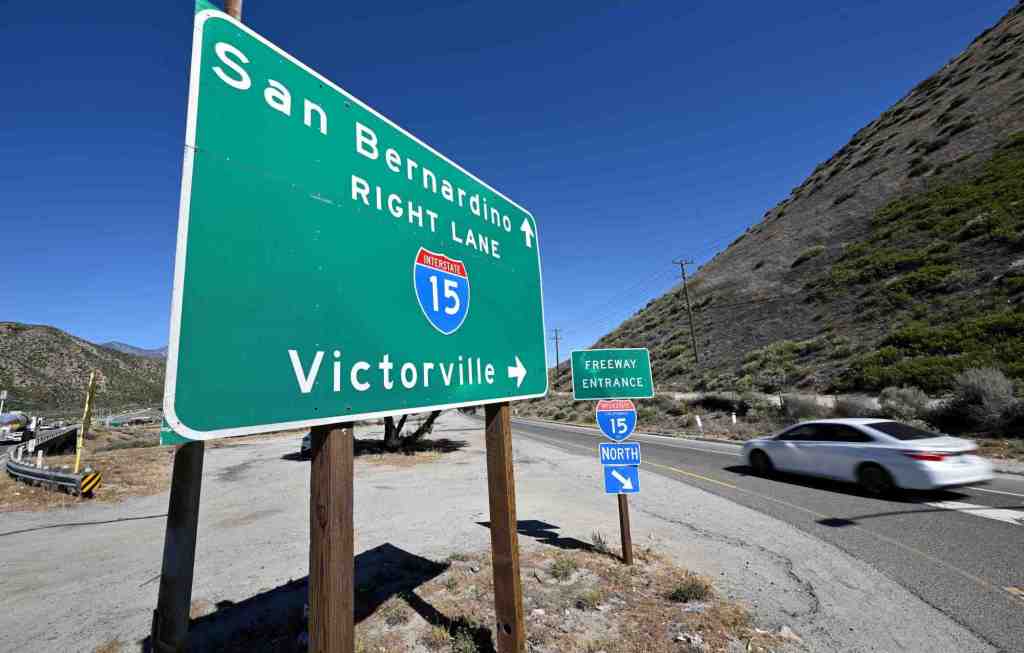
In July 2024, a semi carrying lithium-ion batteries overturned and caught fire near the California desert community of Baker. The incident shut down the I-15 freeway for nearly 43 hours, backed up I-40 and left thousands of travelers stranded in extreme heat. As firefighters worked to contain the blaze, others from our agency moved through the stalled traffic to deliver water, fuel and medical aid.
For San Bernardino County, incidents like this on I-15 exacerbate the dangers that are always present throughout this corridor. It is the reality of a highway that serves as both a Main Street and lifeline.
For High Desert cities like Hesperia, Victorville and Barstow, it carries people to work and school and keeps families connected. It is also a major interstate link between California and Nevada, with 35,000 passenger vehicles and 7,500 trucks crossing the border each day.
I-15 runs through some of the most isolated stretches of the West, where towns and services are scarce. The road cuts across desert basins, mountain passes and valleys where conditions can swing from blistering heat to flash floods or snowstorms.
These extremes shape I-15’s character and make it home to a moving, living community of travelers, truckers and locals who depend on it.
For San Bernardino County Fire and our partner public safety agencies, serving this corridor means working in a place defined by remoteness and volatile conditions. Too often, the highway strains under its own weight. Congestion and infrastructure gaps leave travelers exposed.
The toll is stark: I-15 in San Bernardino County is the deadliest highway in California. Between Barstow and the state line, someone is killed or seriously injured every four days on average. That danger is constant, not just on holiday weekends.
This is especially true where the desert cities dwindle and give way to the vast Mojave, where isolated travelers in two narrow lanes make up a city-sized population without the vital resources of an actual city.
Water sources, especially fire hydrants, are scarce. Fire stations are rarer still. For a 93-mile stretch between Yermo and the state line, the County Fire station in Baker serves as the only dedicated emergency services provider. The personnel housed here respond to over 80 calls per month—including major traffic incidents and fires—each presenting a challenge: how does a single crew hold things in check before more help arrives?
When crisis hits here, there is no safety net nearby.
Long response times quickly burn through the “Golden Hour” — the critical window when getting a patient from injury to surgery can mean the difference between life and death. On congested stretches of I-15, that hour can disappear before an ambulance even reaches the scene. Every minute lost reduces survival chances and can leave victims facing lifelong injuries.
To regional commerce, major highway closures are crippling. Supply chain delays, fuel waste and lost productivity can push losses to more than $2.5 million per hour and lead to higher prices for consumers. For local businesses and logistics firms, the damage is immediate – and holding back our local economies.
This reality can change. With the right investment, I-15 can become the safe and reliable lifeline the community and travelers deserve. That means committing state and federal transportation funds to fast-track infrastructure upgrades, deploying smarter traffic management systems and creating emergency lanes or shoulders so first responders can reach those in need without delay.
For those of us in public safety, this is personal. Every day, we serve the families who rely on this highway and protect the neighbors whose lives depend on a few minutes saved. We need state and federal leaders to act now and fund these critical improvements before more lives are lost.
Daniel R. Munsey serves as fire chief for San Bernardino County Fire Protection District, leading one of the largest fire and emergency service agencies in the nation.



